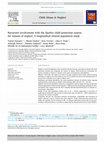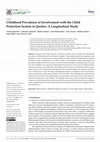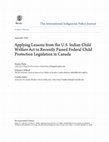Papers by Johanna Caldwell

Child Indicators Research, Feb 7, 2020
The current overrepresentation of Indigenous children in Canadian child welfare systems continues... more The current overrepresentation of Indigenous children in Canadian child welfare systems continues a history of government policies that have separated Indigenous families over the course of many generations. Political and legal developments in recent years are creating the possibility to both disrupt Indigenous children's overrepresentation in child welfare proceedings and support Indigenous self-determination in decision-making related to child welfare. However, the potential to reduce the overrepresentation of Indigenous children in Canadian child welfare systems is still limited, in part, by the absence of a comprehensive framework for transforming existing child welfare legislation. Because the disproportionate representation of Indigenous children is driven largely by investigations of child neglect, there is particular need for a framework for understanding and shifting away from the current approach to assessing neglect cases. In this article, we examine theoretical and legislative conceptualizations of child neglect in terms of their relationship to the disproportionate involvement of Indigenous children in child welfare across Canada and, more specifically, in Quebec. We also briefly examine the concepts of child well-being and cultural safety which we see as useful complements to the current conceptualization of neglect. Our goal is to support ongoing critical dialogue related to the overrepresentation of Indigenous children in Canada's child welfare systems, and in so doing contribute to the development of a new framework for understanding and operationalizing "neglect" in Indigenous contexts which at its core could bolster Indigenous self-determination.

Child Abuse & Neglect, 2021
Studies in several jurisdictions have found that families become recurrently involved with child ... more Studies in several jurisdictions have found that families become recurrently involved with child protection systems most frequently for reasons of neglect. Child protection involvement for reasons of neglect is shown to correlate with various socioeconomic vulnerabilities. Objective: This study, the largest of its kind in Canada, examines when and for whom recurring conditions of neglect were most likely to occur for all children involved with child protection in the province of Quebec over a span of fifteen years. Participants and setting: Specifically, the study population includes all children whose ongoing child protection intervention in Quebec closed between 2002 and 2017 (N = 76,176). Methods: This clinical population study uses a longitudinal research design drawing anonymized clinical administrative data from all of Quebec's child protection jurisdictions spanning 15 years, and Quebec data extracted from the 2011 Canadian National Household Survey to estimate socioeconomic vulnerability. Results: Of the total population studied, 32.5 % (N = 24,816) experienced a recurrence of maltreatment during the study period, of which more than one third (N = 8707) experienced a recurrence for reasons of neglect. Conclusions: Because the association between socioeconomic vulnerability and recurrence of neglect indicates a gap in material and social supports-which child protection systems have neither the mandate nor the resources to fill-we propose additional avenues that we urge policymakers and practitioners to consider in supporting the demonstrated needs of these families.

International Journal of Environmental Research and Public Health
The goal of this study, the first of its kind in Canada, was to estimate the child lifetime preva... more The goal of this study, the first of its kind in Canada, was to estimate the child lifetime prevalence of child protection involvement in Quebec. Using administrative and population data spanning 17 years, we performed a survival analysis of initial incidents of child protection reports, confirmed reports, confirmation of a child’s security or development being compromised, and placement outside the home for one day or more. We found that before reaching the age of 18 years, over 18% of children were reported to child protection at least once, one in every ten children (10.1%) in the province had a report that led to the finding of their security or development being compromised, and over 5% were placed outside the home. We found that neglect was a primary concern in close to half (47.6%) of cases. By using a full population dataset, we obtained a more accurate prevalence estimate than studies using synthetic cohort life tables. These findings only captured initial incidents of invo...

Child Abuse & Neglect
BACKGROUND While family reunification following out-of-home placement is a goal of child protecti... more BACKGROUND While family reunification following out-of-home placement is a goal of child protection policy, complex family needs may not be met at the point that child protection systems reunify families. Permanency legislation creating maximum placement timeframes prompts questions regarding what families need to be supported in stably reunifying following a child's removal from the home. OBJECTIVE We aim to identify clinical risk factors salient for initial placements and placements following a child reunifying with their family to inform successful reunification and improve children's stability. PARTICIPANTS AND SETTING The study includes a representative sample of children in Quebec with a child protection investigation in 2008 (N = 3051) followed for nine years. METHODS Cross-sectional clinical data from the Quebec Incidence Study (QIS) on Evaluated Child Protection Reports (2008) were linked with longitudinal administrative data from 16 provincial child protection agencies. Canadian Census data (2006) were used to create a factorial index measure for poverty. Chi-square automatic interaction detector (CHAID) decision tree analysis was used to compare risk factors salient for initial placements (n = 1120) with post-reunification placements (n = 455). RESULTS For the placement sample (n = 1120), significant factors were: attachment issues, caregiver drug use, child's suicidal thoughts, child's self-harming behavior, and academic difficulties. Of the children who reunified with their families (n = 847), over half (n = 455; 54%) returned to out-of-home placements. Certain factors remained significant for placement after reunification: academic difficulties, attachment issues, and caregiver drug use. The CHAID model fit estimates suggest 70.9% (SE = 0.008) accuracy predicting out-of-home placement following child protection investigation and 58.2% (SE = 0.017) accuracy predicting re-placement following family reunification. CONCLUSIONS Complex needs among families most likely to experience reunification breakdown indicate potential service gaps. When legislated placement timeframes prompt quick resolution of family challenges, these analyses can contribute to policy discussions regarding clinical family challenges that impact stability.
Reference Module in Neuroscience and Biobehavioral Psychology
Children and Youth Services Review

International Indigenous Policy Journal, 2021
A series of recent legal and policy developments in Canada have potential to contribute to reconc... more A series of recent legal and policy developments in Canada have potential to contribute to reconciliation efforts, particularly related to the overrepresentation of Indigenous children in child welfare systems. However, systematic collection, analysis, and synthesis of research knowledge—particularly, research that is locally grounded—on Indigenous child welfare involvement is notably missing from these efforts. With the aim of collating existing research knowledge on this topic, this scoping review of literature includes a broad swath of literature spanning decades (1973-2018) and countries with similar settler colonial histories (Canada, the United States, Australia, and New Zealand). Our search yielded 881 unique research publications. There was an increase in the number of publications over time in all four countries and a trend toward more empirical literature than non-empirical literature. We found that a plurality of publications focused on programs and services (n = 191), an...

On 30 September 1948, an assembly of Palestinian political leaders met in Egypt- controlled Gaza ... more On 30 September 1948, an assembly of Palestinian political leaders met in Egypt- controlled Gaza to declare a Palestinian state. The assembly elected a president and voted on a number of resolutions naming Jerusalem as the capital, using the flag from the 1916 Arab revolt, and adopting a provisional constitution. It further instated an army, created a delegation to send to the United Nations, and issued fourteen thousand passports.1 The All-Palestine Government, as it was called, had the trappings of an emerging nation-state in the post-Mandate period. However, this government existed only nominally for mere weeks before it was dismantled. Internal Palestinian disunity and inter-Arab politics in the wake of Israel's declaration of statehood precluded the possibility of a new Palestinian state. In other words, "It was all farce."2The All-Palestine Government, officially sanctioned by the Arab League in October 1948, never held the sufficient political or military power ...

Developmental Child Welfare, 2020
In many North American jurisdictions, socioeconomically vulnerable families are more likely to be... more In many North American jurisdictions, socioeconomically vulnerable families are more likely to be involved with child protection systems and experience ongoing challenges. The current public health response to the COVID-19 pandemic is having a disproportionate impact on these families via unemployment, “essential” work, isolation, and closures of childcare and schools, with negative implications for children’s developmental wellbeing. Experts warn that while child protection referrals have gone down, children who are at risk of maltreatment are less exposed to typical reporters (e.g., school professionals). At the same time, physical distancing measures are prompting many human service settings to shift toward virtual intervention with children and families. In this commentary, we suggest that a focus on short-term risk in the response to COVID-19 may obscure support for children’s long-term outcomes. We propose two policy considerations: (1) in the immediate term, that child protec...

International Indigenous Policy Journal, 2020
Indigenous children are overrepresented in child protection systems in the United States and to a... more Indigenous children are overrepresented in child protection systems in the United States and to an even greater degree in Canada. Canada has recently passed federal child welfare legislation, Bill C-92, with the goal of affirming the rights of Indigenous Peoples and establishing guidelines with respect to child and family services for Indigenous children. The aim of this article is to contribute to ongoing discussions about the recently passed Canadian legislation, drawing on lessons learned in the United States context. The Indian Child Welfare Act (ICWA), passed in the United States in 1978, has created a legislative paradigm, which in some cases has been bolstered by state-level provisions. The ICWA can provide helpful lessons to consider in Canada as the new legislation is implemented and amended over time. Specifically, we examine elements of the ICWA related to accessibility and compliance with the law, along with deeper analysis of state-level statutes related to adoption pro...

Child Indicators Research, 2020
The current overrepresentation of Indigenous children in Canadian child welfare systems continues... more The current overrepresentation of Indigenous children in Canadian child welfare systems continues a history of government policies that have separated Indigenous families over the course of many generations. Political and legal developments in recent years are creating the possibility to both disrupt Indigenous children's overrepresentation in child welfare proceedings and support Indigenous self-determination in decision-making related to child welfare. However, the potential to reduce the overrepresentation of Indigenous children in Canadian child welfare systems is still limited, in part, by the absence of a comprehensive framework for transforming existing child welfare legislation. Because the disproportionate representation of Indigenous children is driven largely by investigations of child neglect, there is particular need for a framework for understanding and shifting away from the current approach to assessing neglect cases. In this article, we examine theoretical and legislative conceptualizations of child neglect in terms of their relationship to the disproportionate involvement of Indigenous children in child welfare across Canada and, more specifically, in Quebec. We also briefly examine the concepts of child well-being and cultural safety which we see as useful complements to the current conceptualization of neglect. Our goal is to support ongoing critical dialogue related to the overrepresentation of Indigenous children in Canada's child welfare systems, and in so doing contribute to the development of a new framework for understanding and operationalizing "neglect" in Indigenous contexts which at its core could bolster Indigenous self-determination.








Uploads
Papers by Johanna Caldwell